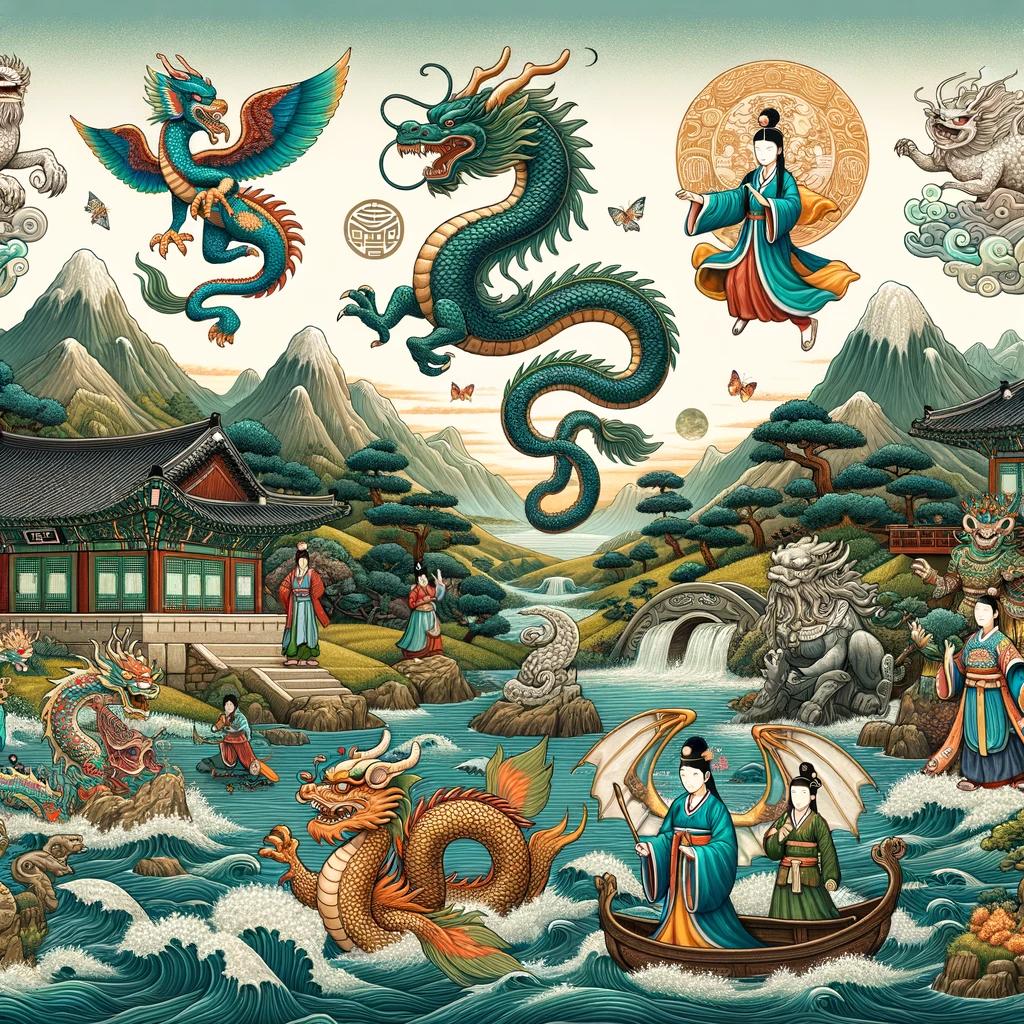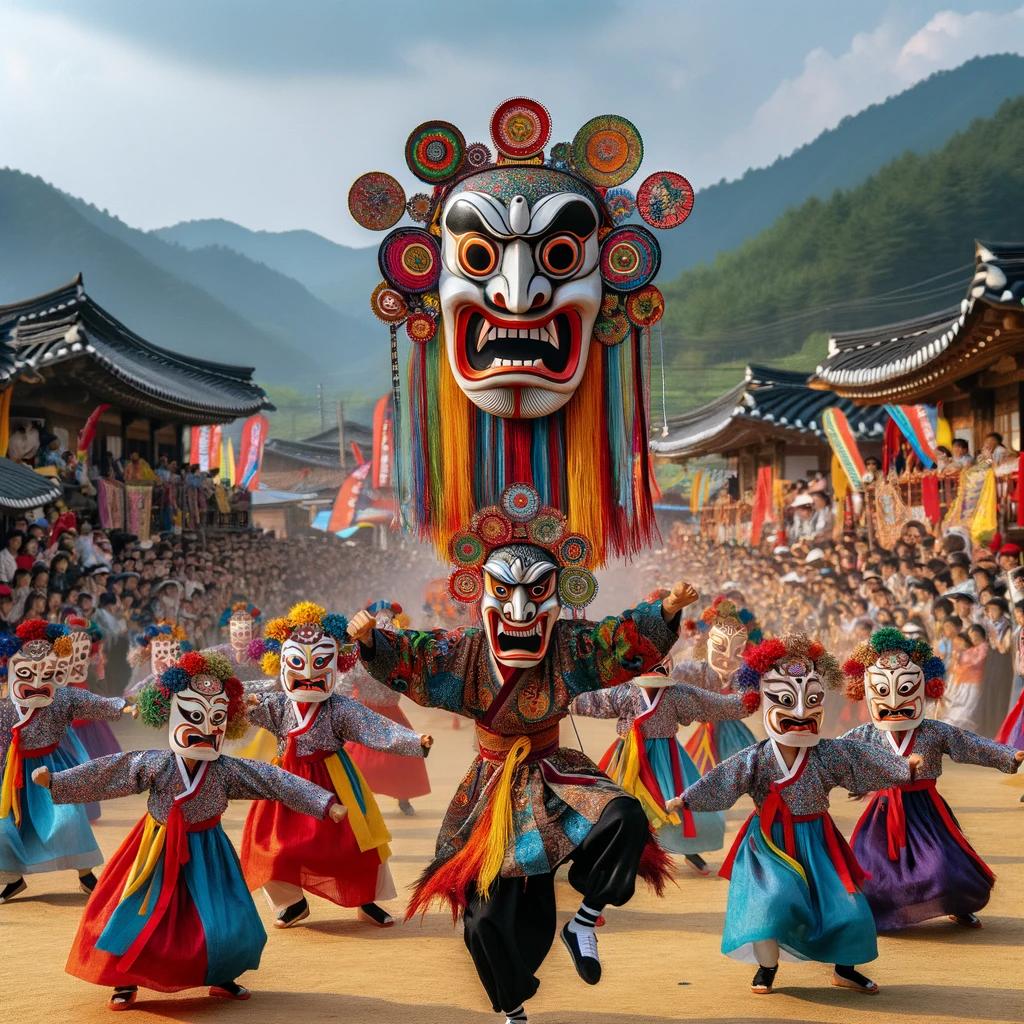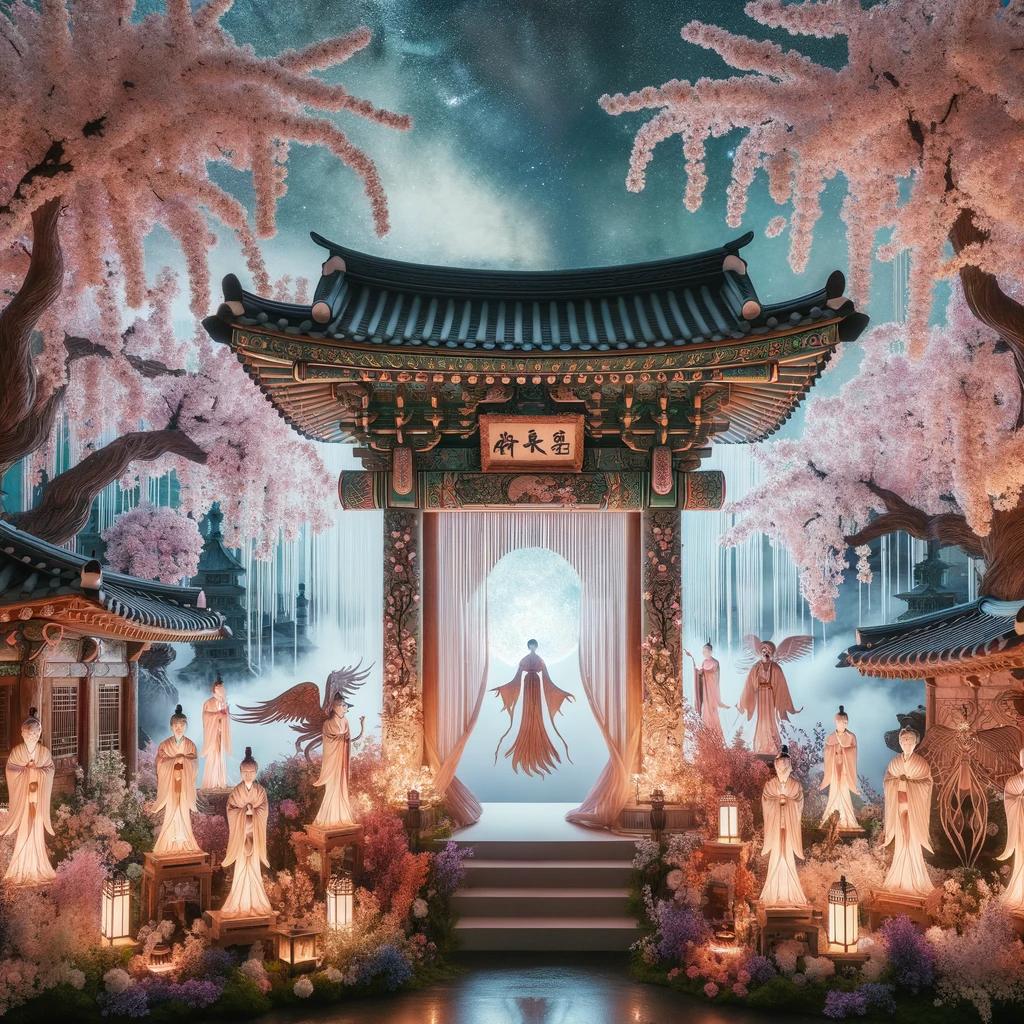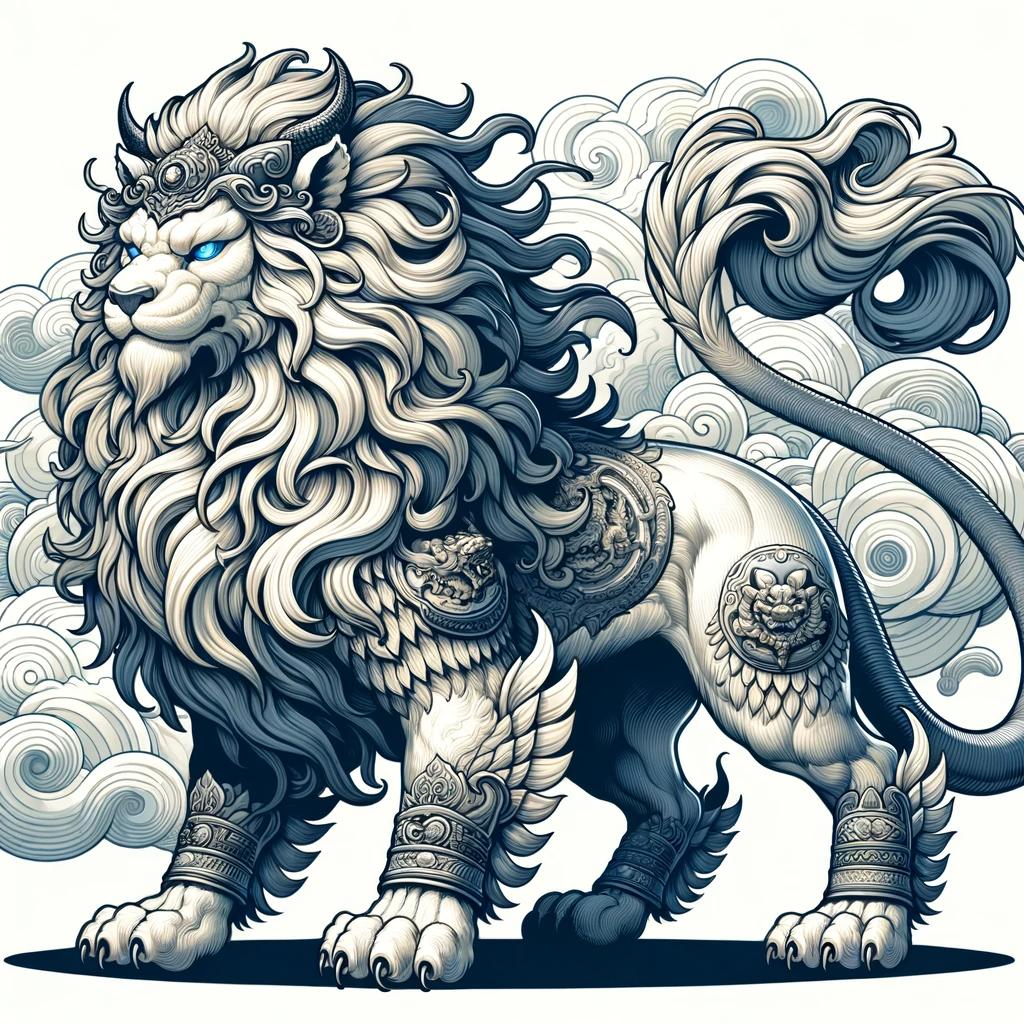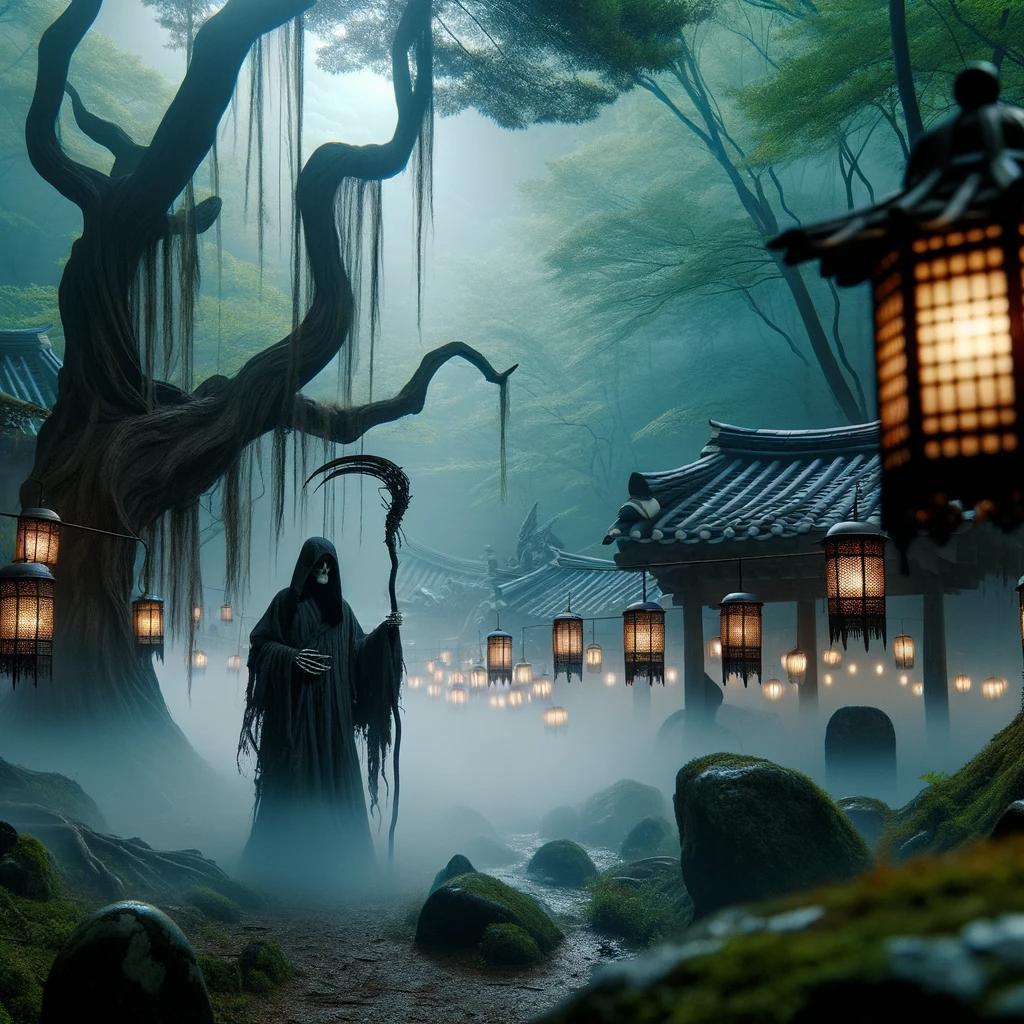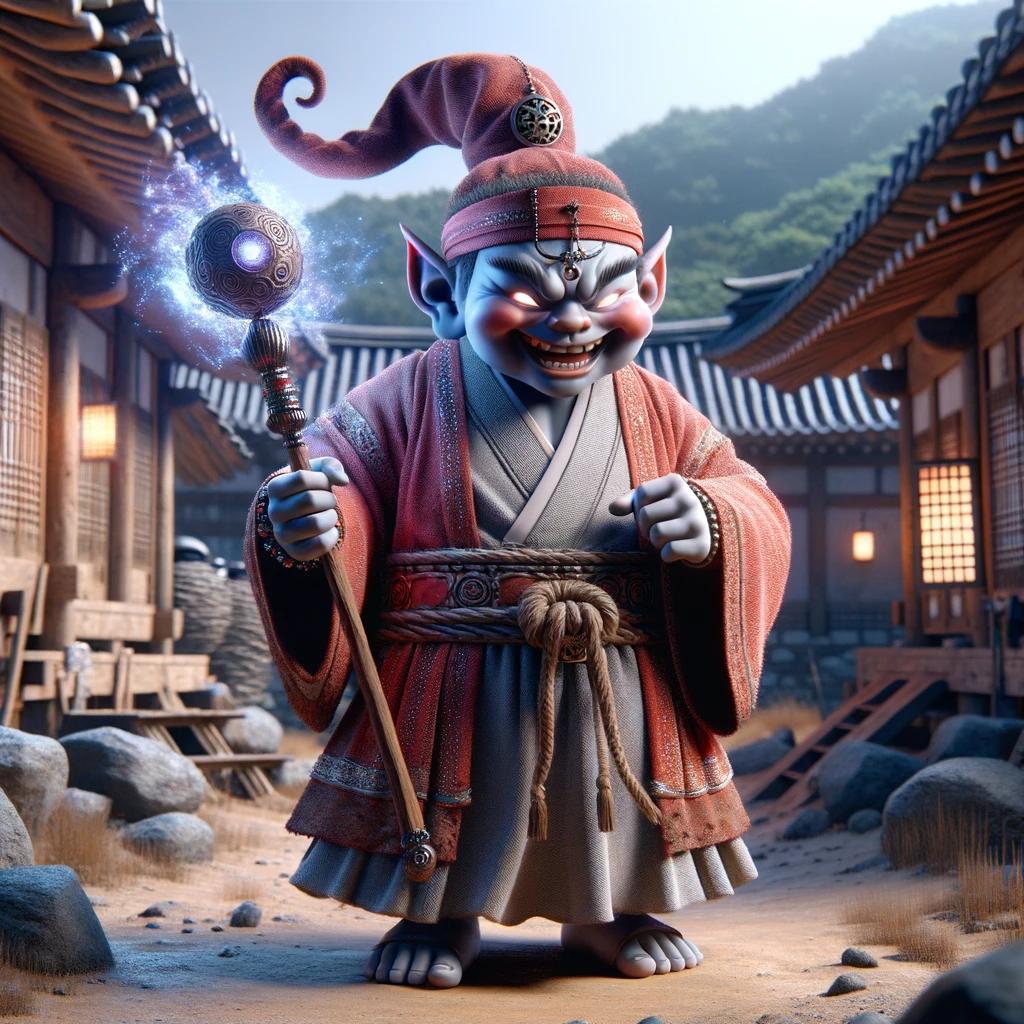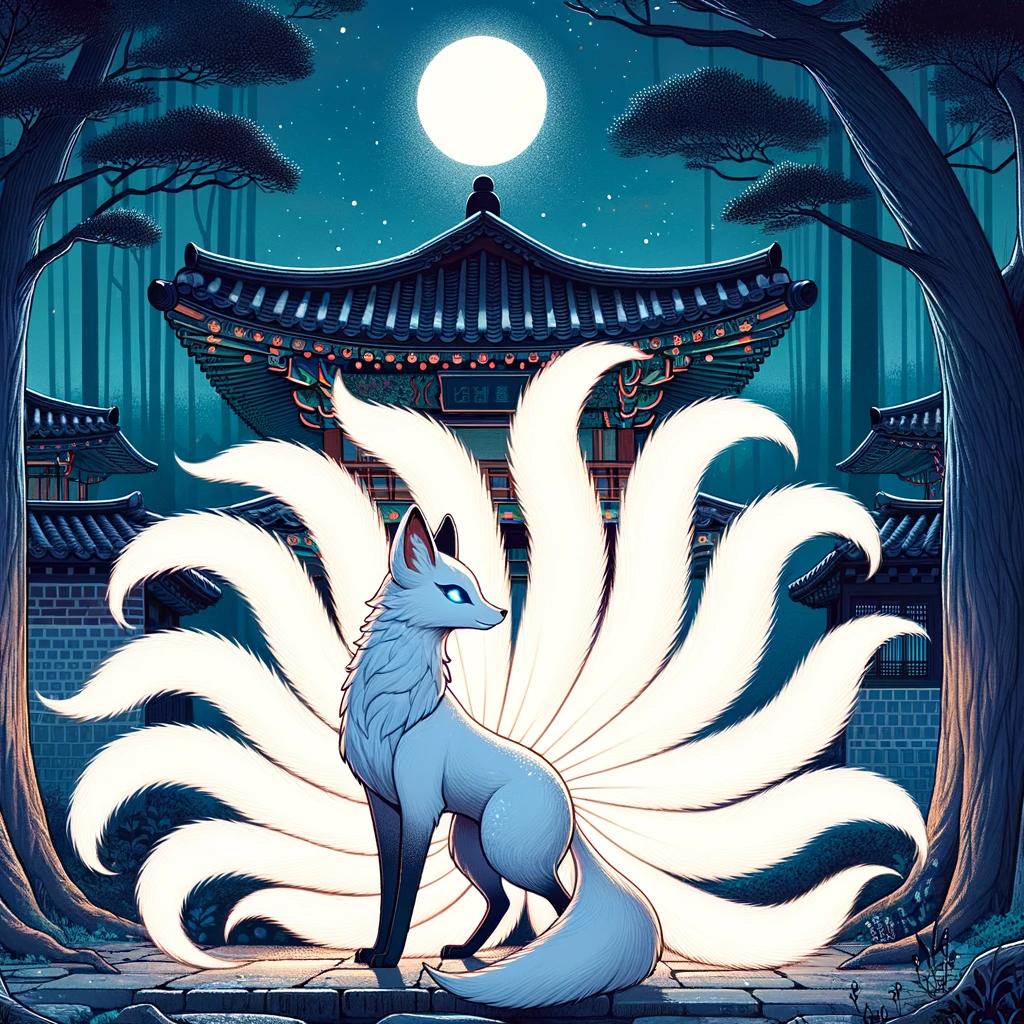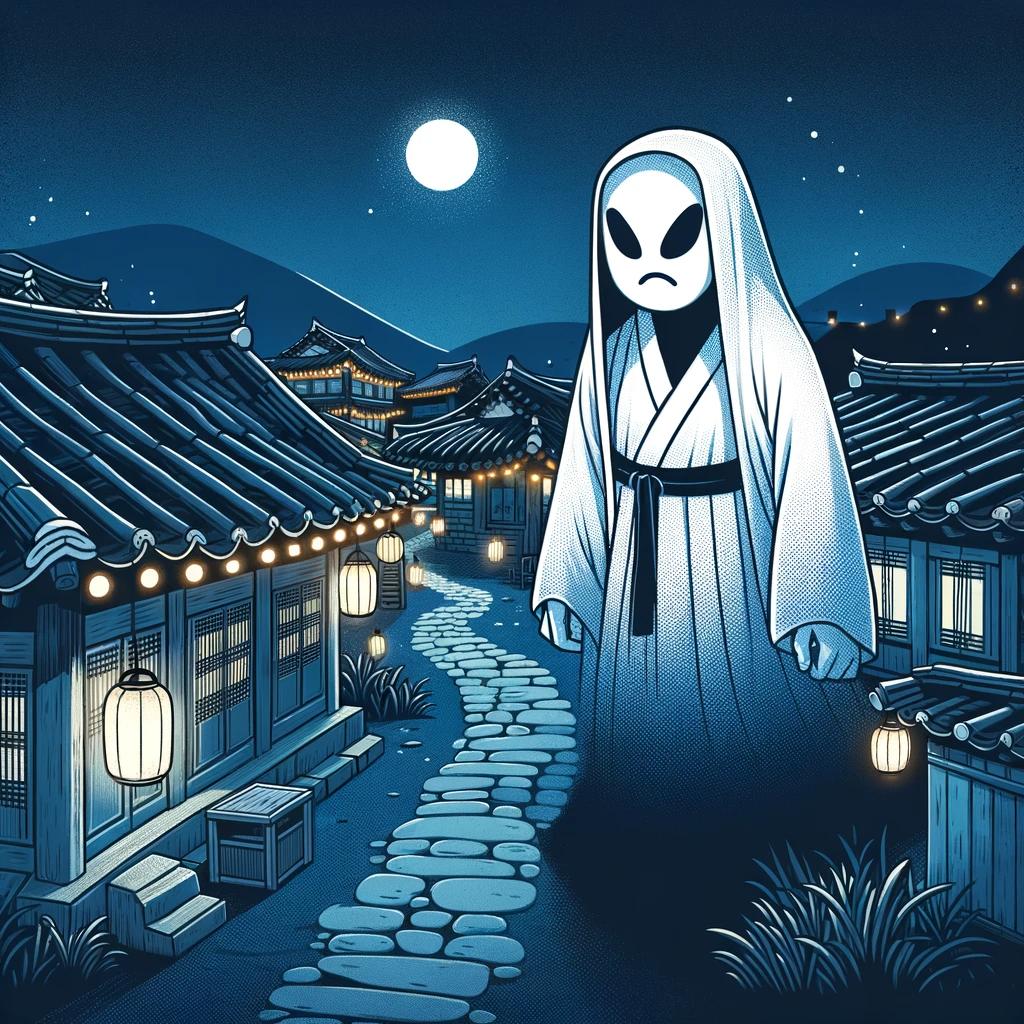Discover the Enigmatic Korean Mythological Creatures: A Fascinating Journey through Ancient Folklore
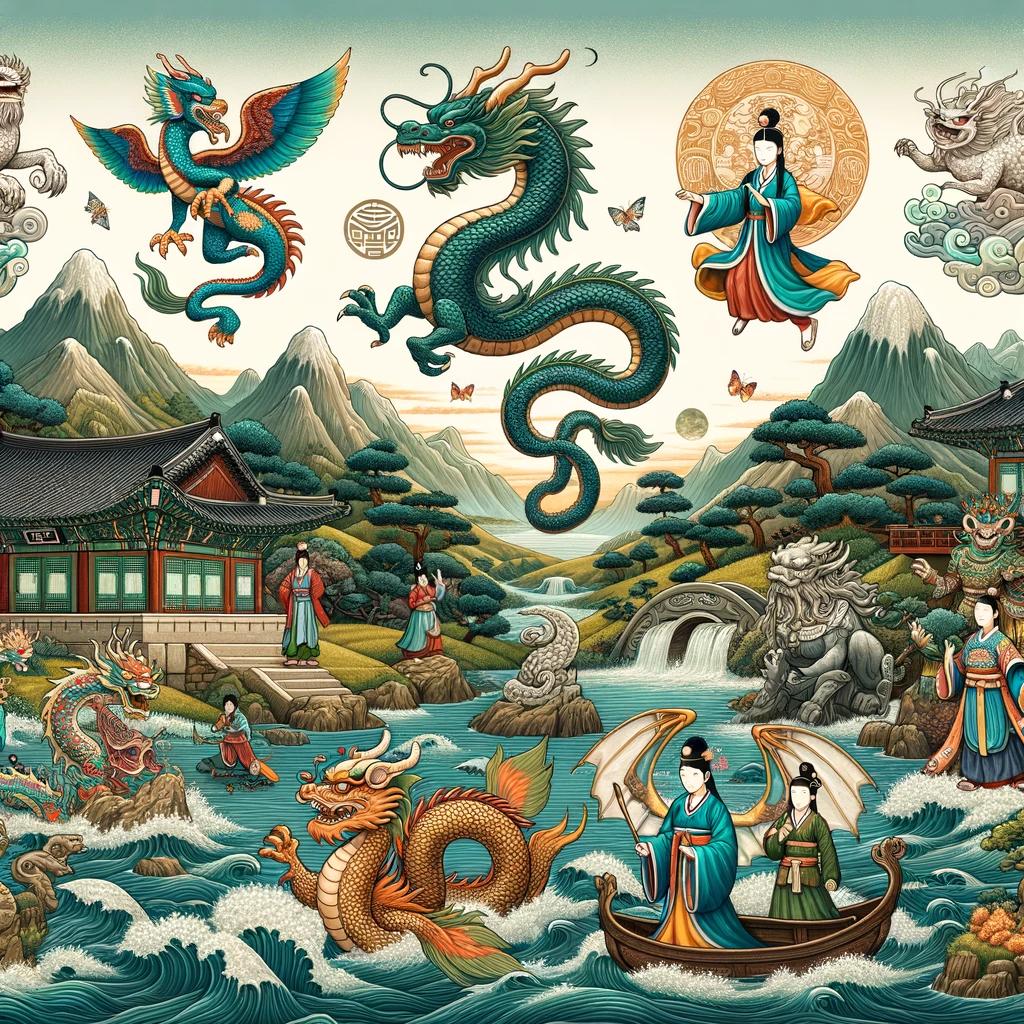
Korean Mythological Creatures have captivated the imagination for centuries in Korean folklore. From the mysterious Nine-Tailed Fox to the legendary Three-Legged Crow, these creatures hold deep cultural significance. Dokkaebi, mischievous spirits, and the powerful Korean Dragons are revered in art and literature.
Gwisin, spirits of the departed, and the enigmatic Grim Reaper feature in haunting tales. Finally, the Moon Rabbit, a divine creature, symbolizes wisdom and grace. Join us on a captivating journey through Korean mythology and discover the fascinating world of these mythical creatures.
Overview of Korean Mythology and Folklore
Korean mythology and folklore are rich and diverse, filled with captivating tales and mythical creatures that have fascinated generations. These stories have been passed down through oral traditions and written texts, providing a glimpse into the beliefs and imaginations of the Korean people.
Korean mythology encompasses a wide range of deities, spirits, and legendary figures, each with their own unique stories and significance. These mythical beings are often intertwined with nature, embodying the forces of the cosmos and the elements of the natural world.
Many of these stories draw inspiration from shamanistic beliefs, which have played a significant role in Korean culture throughout history.
In addition to gods and spirits, Korean mythology is known for its captivating creatures that populate the folklore. These mythological creatures are both fearsome and awe-inspiring, embodying the collective fears and aspirations of the Korean people.
They serve as symbols of power, wisdom, protection, and transformation, leaving a lasting impact on Korean art, literature, and popular culture.
Throughout this article, we will delve into the fascinating world of Korean mythological creatures, exploring their origins, characteristics, and cultural significance. From the enchanting legends of the Nine-Tailed Fox and the Three-Legged Crow to the mischievous Dokkaebi and the noble Korean Dragons, each creature offers a unique perspective into the rich tapestry of Korean mythology and folklore.
Join us on this captivating journey through the realms of Korean mythological creatures, where ancient legends come to life and the imagination knows no bounds.
Korean Mythological Creatures in Popular Culture
Korean mythological creatures have left a lasting impact on popular culture, captivating audiences through various forms of media.
From movies and TV shows to books and video games, these mythical beings have become iconic symbols within Korean pop culture. Let’s delve into how these creatures have made their mark.
The Legend of the Nine-Tailed Fox
The Nine-Tailed Fox, known as Gumiho in Korean folklore, has become a prominent figure in popular culture. Its seductive yet dangerous nature has inspired countless movies, dramas, and graphic novels.
This creature’s tales of love, betrayal, and shapeshifting abilities continue to captivate audiences, weaving a rich tapestry in the realm of Korean entertainment.
The Myth of the Three-Legged Crow
The Three-Legged Crow, with its symbolism of wisdom and divine power, has made appearances in various Korean films and animated shows. Its legendary status as a messenger between the human and divine realms has captured the imagination of filmmakers, showcasing its enigmatic presence in Korean popular culture.
Dokkaebi: Mischievous Creatures of Korean Folklore
Dokkaebi, mischievous goblins known for their supernatural abilities and playful nature, have become beloved characters in Korean dramas and fantasy novels. Their unique appearance and quirky personalities make them fan-favorites, injecting humor and excitement into Korean popular culture.
Korean Dragon: Mythical Creatures of Power and Wisdom
The majestic Korean Dragon, revered for its immense power and wisdom, has become an iconic symbol in Korean media. From epic fantasy novels to blockbuster movies, these creatures take center stage, embodying the strength and intelligence that captivates audiences worldwide.
Gwisin: Spirits of the Departed in Korean Mythology
The presence of Gwisin, spirits of the departed, has instilled a sense of mystery and supernatural intrigue in Korean popular culture. Their haunting tales and eerie encounters have been showcased in horror films, TV series, and ghost-themed video games, creating a chilling atmosphere that keeps audiences on the edge of their seats.
The Legend of the Grim Reaper in Korean Mythology
The Grim Reaper, a concept deeply rooted in Korean mythology, has inspired intriguing storytelling in K-dramas and supernatural-themed films. Its portrayal as a guide between the realms of life and death has fascinated viewers, offering unique perspectives on mortality and the afterlife.
The Moon Rabbit: A Divine Creature in Korean Folklore
The Moon Rabbit, a divine creature symbolizing purity and kindness, has left its mark on Korean popular culture. This enchanting being has been featured in animated films, children’s books, and traditional artwork, embodying the charm and innocence that resonates with audiences of all ages.
The Legend of the Nine-Tailed Fox
The Nine-Tailed Fox holds a prominent place in Korean mythology. Believed to originate from Chinese folklore, this mystical creature is known for its cunning nature and multiple tails. Let’s delve into the origins and characteristics of the Nine-Tailed Fox, explore its powers and abilities, and uncover its cultural significance in Korea.
Origins and Characteristics of the Nine-Tailed Fox
The legend of the Nine-Tailed Fox has roots in ancient East Asian mythology. It is believed to be a shape-shifting creature that takes the form of a fox with nine tails.
In Korean folklore, these foxes possess immense intelligence, long lifespans, and extraordinary beauty. They are often depicted as enchanting beings capable of manipulating their appearance.
Powers and Abilities of the Nine-Tailed Fox
The Nine-Tailed Fox is renowned for its supernatural powers and abilities.
It is believed to possess formidable magical skills, including the power of illusion and shape-shifting. These foxes can transform into humans, animals, or inanimate objects to deceive and seduce their victims.
They are also considered experts in the arcane arts and possess profound knowledge of ancient wisdom.
Cultural Significance of the Nine-Tailed Fox in Korea
The Nine-Tailed Fox holds great cultural significance in Korea. It is often portrayed in various forms of Korean art, literature, and popular culture, symbolizing beauty, intelligence, and seduction. The creature’s allure and mystique have captivated the imagination of Koreans for centuries, reflecting their fascination with supernatural beings and the delicate balance between good and evil.
Explore the captivating tales and enduring legacy of the Nine-Tailed Fox, a mythical creature that continues to captivate imaginations and inspire creativity in Korean culture.
The Myth of the Three-Legged Crow
Legend has it that the Three-Legged Crow holds great symbolism and mythological importance in Korean culture.
Representing the sun, it is believed to possess supernatural abilities and hold a significant place in Korean folklore.
Symbolism and Mythological Importance of the Three-Legged Crow
The Three-Legged Crow, known as Samjok-o in Korean, is associated with the sun, representing its radiant power and celestial influence. This revered creature is considered a symbol of good fortune, longevity, and prosperity in Korean mythology.
Legends and Stories Surrounding the Three-Legged Crow
The Three-Legged Crow appears in various Korean legends and stories, often depicted as a wise creature with divine insights. One popular tale tells the story of how the Three-Legged Crow helped humanity by guiding the first three legendary founders of Korea through a perilous journey.
Representations of the Three-Legged Crow in Korean Art and Literature
The Three-Legged Crow has been a prominent subject in Korean art and literature throughout history. Its unique appearance, with vibrant feathers and three legs, has been captured in paintings, sculptures, and traditional crafts.
These artistic representations serve as a testament to the cultural significance and enduring fascination with this mythical creature.
- The Three-Legged Crow’s depiction in ancient paintings showcases its majestic presence in Korean mythology.
- Statues and figurines of the Three-Legged Crow can be found in historical sites, symbolizing protection and auspiciousness.
- Poems and literary works often highlight the bird’s mythical attributes, celebrating its wisdom and influence.
Dokkaebi: Mischievous Creatures of Korean Folklore
Dokkaebi, also known as Korean goblins, are fascinating and mischievous creatures deeply rooted in Korean folklore.
Believed to possess supernatural powers, Dokkaebi are often depicted as tricksters who love to play pranks on humans. Let’s explore the appearance, characteristics, legends, and cultural significance of these intriguing beings.
Appearance and Characteristics of Dokkaebi
Dokkaebi are often portrayed as supernatural creatures with a humanoid appearance. They are known for their distinctive features, including a horn on their head and a bulging sack that contains magical items.
Dokkaebi are typically depicted wearing traditional Korean clothing, adding to their whimsical and mythical charm.
Legends and Folktales Featuring Dokkaebi
Throughout Korean folklore, various legends and folktales revolve around Dokkaebi. These tales often portray Dokkaebi interacting with humans, either helping or causing mischief. They are known for their cunning nature and clever schemes, which often serve as cautionary tales or bring a sense of wonder to the listeners.
Examples of Legends and Folktales:
- The Dokkaebi’s Magic Club: A tale about a man who encounters a Dokkaebi and is granted a magic club that can solve any problem, with unintended consequences.
- The Dokkaebi’s Braids: A story where a Dokkaebi uses his magical braids to assist a poor family, teaching them valuable life lessons along the way.
- The Dokkaebi’s Game: In this legend, a Dokkaebi challenges a skilled hunter to a game with high stakes, testing the hunter’s wit and determination.
Cultural Significance and Beliefs Associated with Dokkaebi
Dokkaebi hold significant cultural value in Korea and have become an integral part of its identity.
They represent the blend of humor, mischief, and supernatural beliefs deeply ingrained in Korean culture. Dokkaebi are often seen as protectors of the weak and symbols of good fortune. They are also associated with prosperity, as their sacks symbolize abundance and wealth.
Today, Dokkaebi continue to inspire various forms of artistic expression, ranging from literature and paintings to popular culture adaptations, cementing their place as iconic figures in Korean folklore.
Korean Dragon: Mythical Creatures of Power and Wisdom
Dragons hold a significant place in Korean mythology, symbolizing power, wisdom, and strength.
These majestic creatures are revered across East Asian cultures, and in Korea, they are associated with various legends and tales.
Symbolism and Significance of Korean Dragons
Korean dragons are often regarded as divine beings, representing imperial authority and good fortune. Their long, serpentine bodies are seen as a symbol of the unification of heaven and earth, and they are believed to bring blessings and protect against evil spirits.
Depictions of Korean Dragons in Art and Architecture
The artistic representations of Korean dragons are elaborate and visually captivating. These mythical creatures are a common motif in traditional Korean art, appearing in paintings, sculptures, and even on royal palaces.
Their intricate details and dynamic poses showcase their majestic presence and mythical allure.
Connections between Korean Dragons and East Asian Mythology
Korean dragons share similarities with dragons from other East Asian cultures, such as China and Japan. They all possess a profound connection to the heavens, embodying the elements of water and the sky.
This interplay of cultural influence reflects the widespread belief in these mighty creatures’ existence and their enduring impact on the region’s mythology.
In summary, Korean dragons are mythical beings steeped in symbolism, revered for their power, wisdom, and protection.
Their artistic representations and cultural significance provide a glimpse into the rich tapestry of Korean mythology and its interconnectedness with the wider East Asian heritage.
Gwisin: Spirits of the Departed in Korean Mythology
Welcome to the captivating realm of Gwisin, the spirits of the departed in Korean mythology.
In Korean folklore, Gwisin are believed to be the souls of those who have died tragically, unsettled in the afterlife. Let’s delve into the fascinating beliefs, haunting encounters, and rich rituals and traditions associated with these ethereal beings.
Beliefs and Folklore Surrounding Gwisin
Gwisin hold a significant place in Korean mythology, where they are considered as beings caught between the realms of the living and the dead. These spirits are believed to reside in haunted places, seeking solace and resolution for their untimely demise.
Korean folklore is replete with tales of Gwisin’s restless souls and their interactions with the living.
Hauntings and Supernatural Encounters with Gwisin
Encounters with Gwisin are often described as eerie and unsettling. People claim to have witnessed apparitions, unexplained noises, and objects moving by themselves in locations believed to be haunted by Gwisin.
These encounters have shaped the popular imagination and continue to spark curiosity and intrigue.
Rituals and Traditions Associated with Gwisin in Korean Culture
Korean culture has developed various rituals and traditions to honor and appease the Gwisin. These practices aim to bring peace to the spirits and provide comfort to the living. From ancestral rituals to specific activities performed during the Ghost Month, these traditions are deeply ingrained in Korean society, showcasing the enduring connection between the living and the departed.
Discover the captivating world of Gwisin and uncover the intriguing beliefs, supernatural encounters, and profound rituals surrounding these spirits. Immerse yourself in the enigmatic realm of Korean mythology and gain a deeper understanding of the enduring presence of Gwisin in Korean culture.
The Legend of the Grim Reaper in Korean Mythology
The Grim Reaper, known as “Jeoseung Saja” in Korean folklore, holds a significant role in the mythology and beliefs of Korea. This enigmatic figure is associated with death and the afterlife, embodying the concept of the soul’s journey beyond the mortal realm.
Origins and Interpretations of the Grim Reaper in Korea
The origins of the Grim Reaper in Korean mythology can be traced back to ancient beliefs in the cycle of life and death. In Korean folklore, it is believed that when a person passes away, the Grim Reaper appears to guide their soul to the afterlife.
This interpretation of the Grim Reaper is seen as a guardian spirit, ensuring a safe transition for the departed.
Depictions of the Grim Reaper in Korean Art and Media
The Grim Reaper is often depicted as a cloaked figure carrying a scythe, symbolizing the harvesting of souls.
In Korean art and media, this iconic image is portrayed in various forms, including paintings, sculptures, and modern representations in movies and television shows. The visual representation of the Grim Reaper reflects the solemn yet mysterious nature of its role in Korean mythology.
Cultural Perspectives and Beliefs about the Grim Reaper in Korea
In Korean culture, the Grim Reaper is viewed with both fear and reverence. The belief in the Grim Reaper’s presence during the moment of death instills a sense of awe and respect for the afterlife.
People often hold rituals and ceremonies to honor and appease the Grim Reaper, ensuring a peaceful passage for their loved ones. These cultural perspectives and beliefs highlight the deep-rooted connection between Korean mythology and the understanding of mortality.
The Moon Rabbit: A Divine Creature in Korean Folklore
The Moon Rabbit, also known as the Jade Rabbit, is a fascinating and sacred creature deeply rooted in Korean folklore. It holds a significant place in Korean mythology and is associated with numerous legends and traditions.
Origins and Legends of the Moon Rabbit
According to the myth, the Moon Rabbit resides on the moon and can be observed pounding ingredients in a mortar to make the elixir of immortality. The origins of this mythical creature can be traced back to ancient East Asian legends, including Chinese and Japanese folklore.
In Korean mythology, the Moon Rabbit is believed to have gained its prominent lunar presence through a celestial test.
One famous legend tells the story of a rabbit who encountered an old man during a famine.
The rabbit selflessly offered itself to the man as food, revealing its compassion and altruism. This act of sacrifice earned the rabbit a special place in the Moon Palace as a divine creature, forever serving as a symbol of selflessness and kindness.
Symbolism and Cultural Significance of the Moon Rabbit
The Moon Rabbit carries profound symbolism in Korean culture. It symbolizes longevity, purity, and gracefulness. Its association with the moon represents the cycle of life, renewal, and the eternal nature of the celestial bodies.
The Moon Rabbit is also considered a guardian and protector, offering blessings and good fortune to those who honor its presence.
In Korean folklore, the Moon Rabbit is often depicted as a companion to the moon goddess, Chang’e, and is believed to accompany her during her lunar activities.
The presence of the Moon Rabbit during the autumn harvest festival, Chuseok, is highly celebrated and regarded as a symbol of abundance and prosperity.
Moon Rabbit Representations in Korean Art and Literature
The Moon Rabbit has left a significant impact on various forms of Korean art and literature throughout history.
It is commonly featured in traditional paintings, sculptures, and ceramics. Artists beautifully capture its elegance, often showing the rabbit holding a mortar or pounding ingredients.
In literature, the Moon Rabbit frequently appears in folktales and poetry, symbolizing purity of heart and the pursuit of enlightenment.
Its gentle and serene demeanor serves as an inspiration for moral virtues and spiritual growth.
- The Moon Rabbit’s portrayal in art and literature showcases the deep admiration and reverence Koreans hold for this mythical creature.
- Artistic representations often convey a sense of tranquility and mysticism, inviting viewers to connect with the spiritual realm.
- Through its presence in Korean cultural expressions, the Moon Rabbit continues to captivate and inspire both locals and visitors alike.
The Moon Rabbit’s enduring presence in Korean folklore and artistic expressions serves as a testament to the rich heritage and profound beliefs surrounding mythical creatures in Korean culture.
Exploring and appreciating the enchanting tales and symbolism associated with the Moon Rabbit provides insight into the spiritual and philosophical aspects of Korean society.
Experience the captivating allure of the Moon Rabbit as you delve deeper into the fascinating realm of Korean Mythological Creatures.
.

